Are you frustrated when your drawers keep falling off their tracks? Are you tired of constantly having to reattach or fix them? Follow these simple steps to learn how to prevent your drawers from falling out and keep them running smoothly.
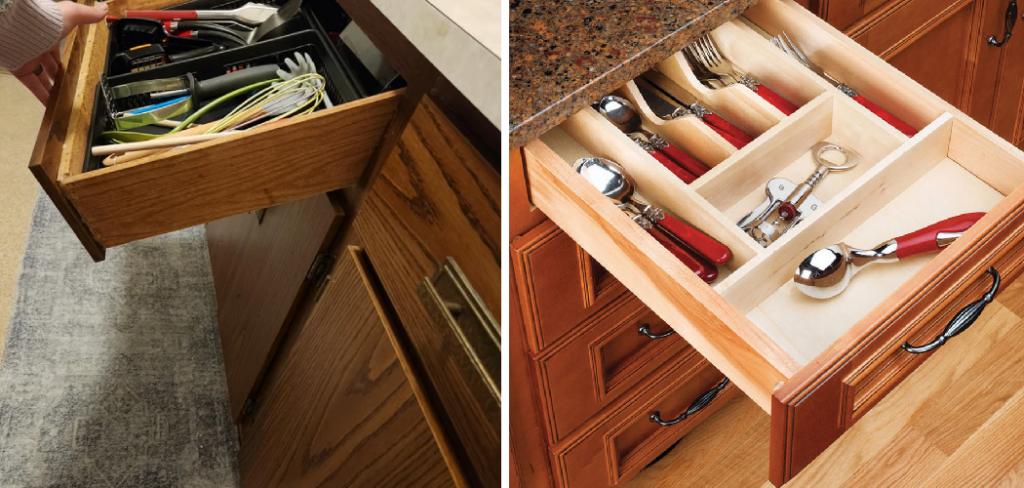
One common frustration when it comes to furniture is drawers that constantly fall out. Whether in a dresser, desk, or cabinet, this issue can be annoying and potentially dangerous if the drawer falls on your foot or causes other items to spill out.
Fortunately, there are some easy solutions to prevent drawers from falling out and keep them securely in place. This guide on how to stop drawers falling out will discuss some simple tips and tricks to help you stop drawers from falling out.
Why Do Drawers Fall Out?
Before we dive into how to stop drawers from falling out, it’s important to understand why this issue occurs in the first place. There are a few common reasons why drawers may fall out:
- Damaged or Worn-out Drawer Tracks: Over time, the tracks that hold your drawers in place can become damaged or worn down, causing the drawer to slip or fall out.
- Loose Screws and Hardware: Loose screws, brackets, and other hardware can also lead to drawers falling out. If the screws holding the tracks in place become loose, the drawer may not be able to stay in place.
- Overloaded Drawers: Another common reason for drawers falling out is overloading them with too much weight. This puts extra strain on the tracks and can cause them to break or bend.
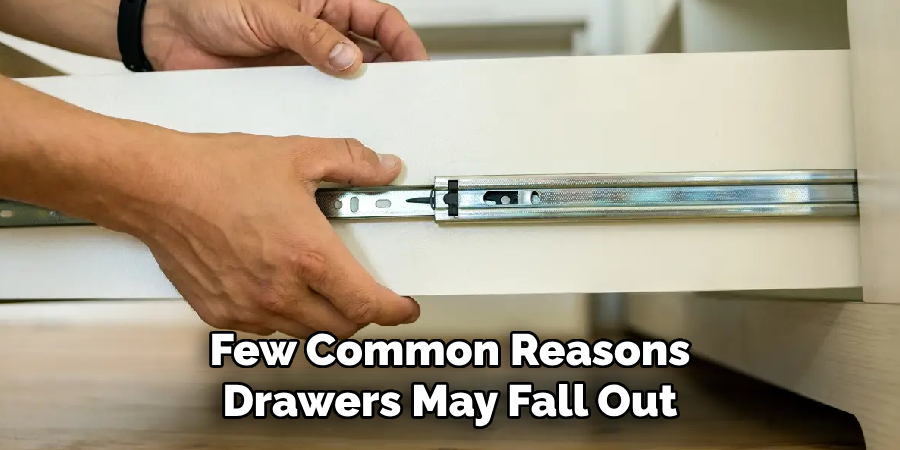
These are just a few common reasons drawers may fall out, but thankfully, there are simple solutions to prevent these issues from occurring. Let’s take a look at some steps you can take to keep your drawers in place.
What Will You Need?
Before you get started, here are the materials and tools that you will need to stop your drawers from falling out:
- Screwdriver: A screwdriver will be necessary for tightening any loose screws or hardware.
- Drawer Slide Brackets: If your drawer tracks are damaged, you may need to replace them with new brackets.
- Wood Glue: If the tracks are loose, adding wood glue can help secure them.
- Drawer Dividers: To prevent overloading your drawers, invest in drawer dividers to help evenly distribute weight.
Now that you have everything you need, let’s start fixing those pesky falling drawers!
10 Easy Steps on How to Stop Drawers Falling Out
Step 1: Check the Tracks
The first step in preventing your drawers from falling out is to thoroughly inspect the tracks. Slide the drawer out and closely examine the tracks mounted to both the drawer and the cabinet.
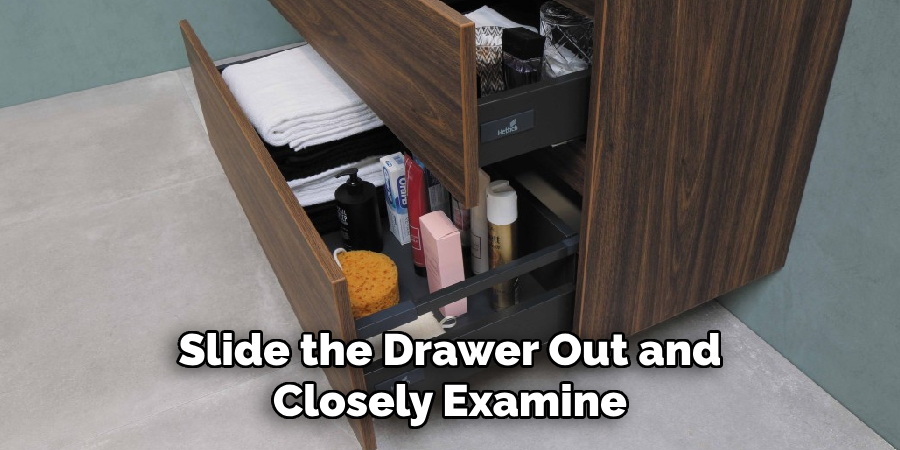
You’re checking for any signs of damage, wear, or misalignment. It’s common for the tracks to become bent or the bearings to wear out over time, especially with heavy use. If the tracks are damaged or excessively worn, they won’t be able to properly support the drawer, leading to it falling out.
Step 2: Tighten All Screws
Once you’ve inspected the tracks for any noticeable damage or wear, the next step is to ensure all screws are tight. Use your screwdriver to tighten any loose screws you find on the drawer and the cabinet’s tracks. This simple action can significantly improve the stability of the drawer, preventing it from falling out. Sometimes, the solution is as straightforward as securing the hardware that holds everything together. If any screws are missing, replace them with new ones that match the size and length of the originals.
Step 3: Install Drawer Slide Brackets
If tightening the screws doesn’t solve the problem, consider installing new drawer slide brackets. These brackets can reinforce the existing tracks or replace damaged ones, providing a stronger foundation for your drawers. First, remove the drawer and unscrew the old tracks to install new brackets.
Position the new slide brackets according to the manufacturer’s instructions, usually ensuring they are level and aligned with the drawer’s bottom. Secure them with screws and test the drawer’s fit. Sometimes, upgrading to higher-quality drawer slides can significantly affect the drawer’s stability and prevent it from falling out again.
Step 4: Apply Wood Glue for Extra Stability
In cases where the drawer or the tracks have become loose, applying a bit of wood glue can provide extra stability. If the tracks are in good condition but don’t fit snugly, try applying a thin layer of wood glue to the area where the track meets the cabinet or drawer.
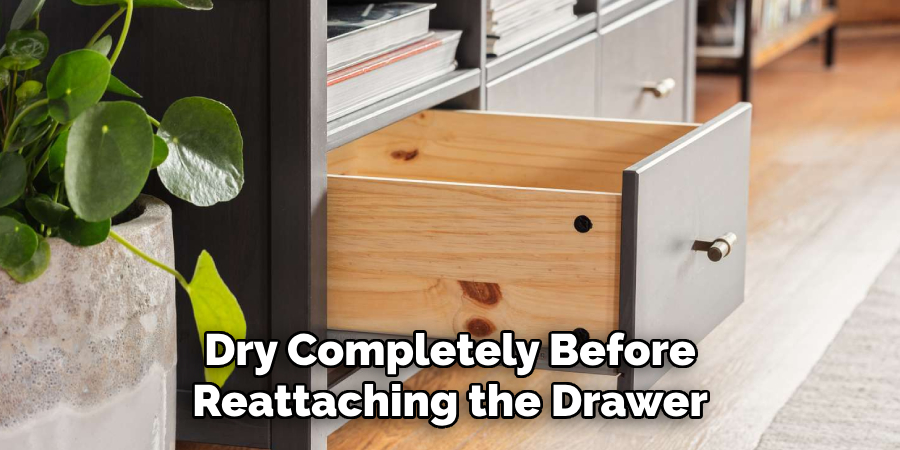
Allow the glue to dry completely before reattaching the drawer. This can help to stabilize the drawer and prevent it from falling out due to minor movements. Make sure to use strong wood glue that dries clear to avoid any visible mess.
Step 5: Use Drawer Dividers to Distribute Weight
An often overlooked solution for preventing drawers from falling out is the use of drawer dividers. Overloading drawers can cause the tracks to bend or break, leading to drawers that fall out or stick. By using drawer dividers, you can evenly distribute the weight of the items stored inside, thus reducing the strain on the tracks.
These dividers can also help organize your items, making them easier to find and access. Choose adjustable dividers that can fit various drawer sizes and allow for customizable organization options to best suit your needs.
Step 6: Regularly Clean and Lubricate the Tracks
An essential maintenance step to prevent drawers from falling out is regularly cleaning and lubricating the tracks. Dirt, dust, and debris can accumulate over time, causing the tracks to stick or jam. To clean, simply slide the drawer out and use a brush or vacuum to remove any debris from the tracks.
After cleaning, applying a silicone-based lubricant to the tracks can help them operate smoothly. Avoid using oil-based products, as these can attract more dirt. This simple upkeep can significantly extend the life of your drawer tracks and ensure they function properly, preventing drawers from slipping out unexpectedly.
Step 7: Adjust Drawer Stops
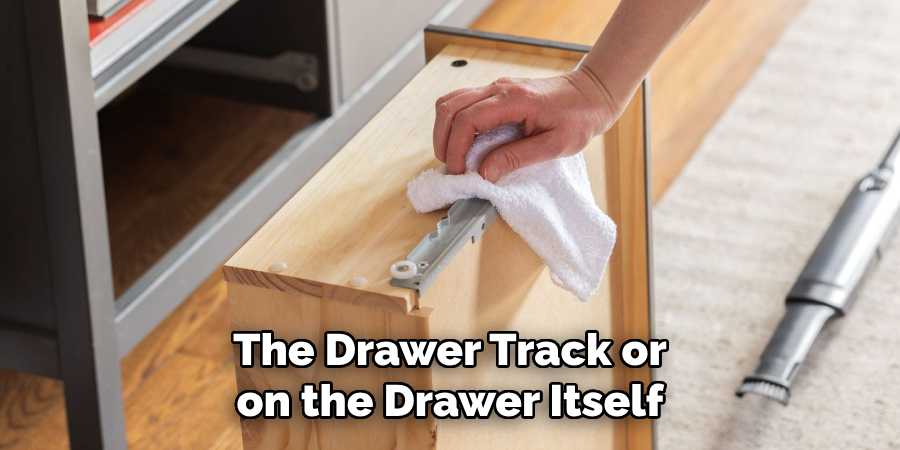
Drawer stops are a small but crucial detail in preventing drawers from falling out. These stops are often located at the back of the drawer track or on the drawer itself and are designed to prevent the drawer from being pulled out too far. If your drawers keep falling out, check to see if the drawer stops are missing or have become worn out.
Replacing or adjusting these stops can provide an easy fix. For most models, simply unscrewing the old stop and screwing a new one in its place will suffice. Ensure the stop is securely attached and properly aligned to keep the drawer in place.
Step 8: Reinforce Drawer Bottoms
If the drawers continue to fall out despite trying the previous steps, it might be due to a weak or sagging drawer bottom. Over time, the bottom of the drawer can become bowed or detached from the sides, especially in drawers holding heavier items. To reinforce the drawer bottom, first remove it and apply a generous amount of wood glue along the edges where it meets the sides of the drawer.
Clamping the edges until the glue dries can ensure a tight bond. Additionally, inserting a few small nails or screws along the bottom can provide extra support and prevent future sagging. Reinstall the drawer and test its stability once the bottom is securely attached and reinforced. This step can significantly prevent the drawer from falling out by ensuring it retains its structural integrity.
Step 9: Consider Professional Repair or Replacement
If, after following these steps, your drawer still tends to fall out, it may be time to seek professional help or consider replacing the drawer entirely. A carpenter or a furniture repair specialist can assess the issue and offer a more permanent solution, whether it involves repairing the existing drawer or installing a new one.
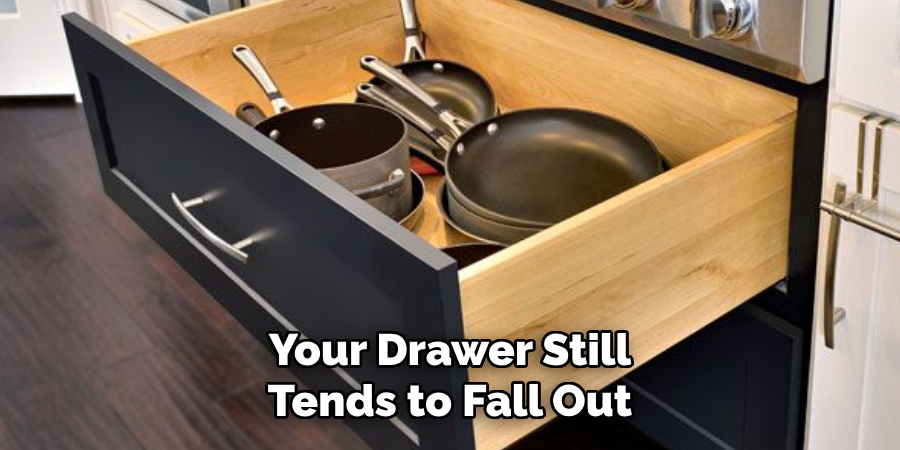
Sometimes, the problem may lie deeper within the cabinet structure or may require tools and skills beyond the average DIY project. Investing in professional repair or a high-quality replacement drawer can save time and frustration in the long run, ensuring your drawers function smoothly and reliably.
Step 10: Review and Test the Drawer Functionality
After completing the repairs or adjustments to prevent the drawer from falling out, it is crucial to thoroughly test the drawer’s functionality. Open and close the drawer several times to ensure it slides smoothly without sticking or falling out. Pay attention to how the drawer sits when closed — it should be flush with the cabinet. If the drawer operates as expected, your repair efforts have been successful.
However, if issues persist, you may need to revisit the previous steps for potential adjustments or consider additional measures. Regular monitoring and timely maintenance of your drawers can prevent future problems and prolong the lifespan of your furniture.
By following these steps, you can effectively prevent drawers from falling out and ensure your furniture remains safe and functional.
5 Additional Tips and Tricks
- Install Drawer Stops: One straightforward solution is to install drawer stops. These small, often plastic devices can be attached to the back or sides of the drawer track, preventing the drawer from being pulled out too far.
- Use Rubber Bands or Twist Ties: Consider wrapping rubber bands or twist ties around the drawer’s roller guides for a quick DIY fix. This creates a simple barrier that can stop the drawer short of falling out.
- Adjust the Tilt of the Furniture: Sometimes, simply adjusting the tilt of the furniture piece can prevent drawers from falling out. If the furniture leans forward, it may encourage drawers to slide open. Adjusting the legs for a slight backward tilt can help.
- Install a Drawer Lock: A drawer lock isn’t just for childproofing. It can also effectively keep drawers securely closed, especially in mobile environments like RVs or boats.
- Enhance Drawer Slides: Upgrading or repairing worn-out drawer slides can greatly reduce the chances of drawers falling out. Consider installing full-extension drawer slides that offer a locking feature when fully opened.
With these additional tips and tricks, you can ensure your drawers stay safely closed and prevent any accidents.
5 Things You Should Avoid
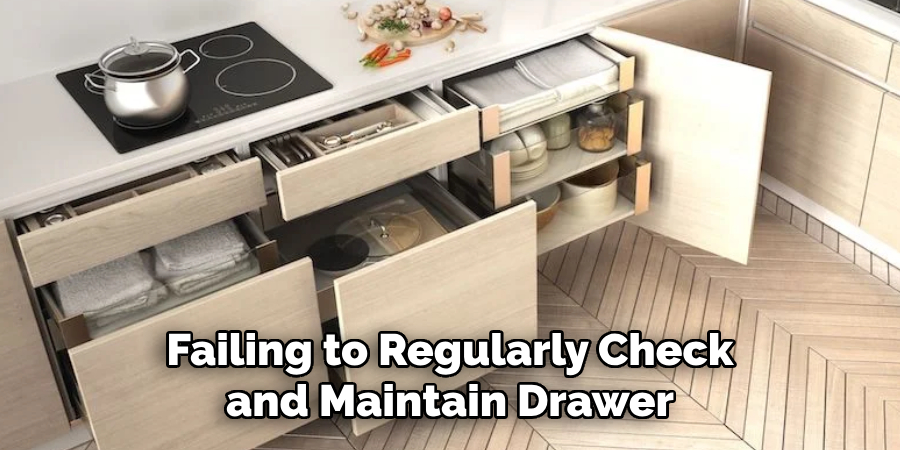
- Ignoring Regular Maintenance: Failing to regularly check and maintain drawer slides and stops can lead to wear and damage over time, making them less effective at preventing drawers from falling out.
- Overloading Drawers: It’s important to avoid overfilling drawers with too much weight. This not only puts strain on the drawer slides but can also cause the drawer to fall out due to the excess weight.
- Using Makeshift Fixes Without Long-Term Solutions: While rubber bands and twist ties might work as a quick fix, relying solely on these methods without installing proper drawer stops or locks can lead to recurrent issues.
- Neglecting to Secure Furniture to the Wall: Especially in homes with children or pets, furniture that isn’t secured to the wall poses a risk of tipping over. Drawers that fall out easily can contribute to this hazard.
- Choosing the Wrong Type of Drawer Slides: Not all drawer slides are suitable for every drawer. Using slides that are too weak to support the drawer’s weight or content can lead to malfunction and accidents. Always select drawer slides appropriate for the drawer’s intended use.
By avoiding these actions, you can ensure the safety and functionality of your drawers for years to come.
What are the Disadvantages of Falling Drawers?
While falling drawers may seem like a minor inconvenience, they can actually lead to a range of issues and dangers. Some disadvantages of falling drawers include:
- Damaged or Broken Items: When a drawer falls out unexpectedly, it can cause items inside to break or become damaged. This is especially concerning for fragile or valuable items.
- Injury or Accidents: Falling drawers can pose a risk of injury or accidents, especially if the drawer contains heavy items. This is a particular concern for children and pets who may be near the furniture when the drawer falls out.
- Wear and Tear on Furniture: Repeatedly pulling out a falling drawer can cause wear and tear on both the furniture piece itself and the drawer’s hardware. This can lead to additional maintenance or replacement costs in the long run.
- Disorganization and Frustration: A falling drawer that spills its contents can cause disorganization and frustration, especially if it happens frequently. This can be a time-consuming issue to deal with, affecting productivity and peace of mind.
By addressing any issues with falling drawers early on, you can avoid these disadvantages and ensure the safety and functionality of your furniture.
How Can You Make Your Drawers Last Longer?
To prevent issues with falling drawers and extend the lifespan of your furniture, here are some tips to make your drawers last longer:
- Regular Maintenance: Regularly check and clean drawer slides and hardware to keep them in good working condition.
- Proper Use: Avoid overfilling drawers or using excessive force when pulling them out. This can put unnecessary strain on the hardware and contribute to wear and tear.
- Proper Installation: When installing drawers or drawer slides, make sure they are properly aligned and secured for optimal performance.
- Choose Quality Materials: Investing in high-quality materials for your drawers and hardware can ensure their durability and longevity.
- Consider Upgrades: If you have older furniture, consider upgrading to newer and more durable drawer slides or adding additional features like locking mechanisms for added stability.
By following these tips, you can make your drawers last longer and save yourself from potential issues with falling drawers. Remember, prevention is key in maintaining the safety and functionality of your furniture.
What is the Sliding Mechanism in a Drawer Called?
The sliding mechanism in a drawer is commonly referred to as the “drawer slide” or “drawer runner.” These mechanical devices enable the drawer to move in and out smoothly by reducing friction and providing a guided pathway.
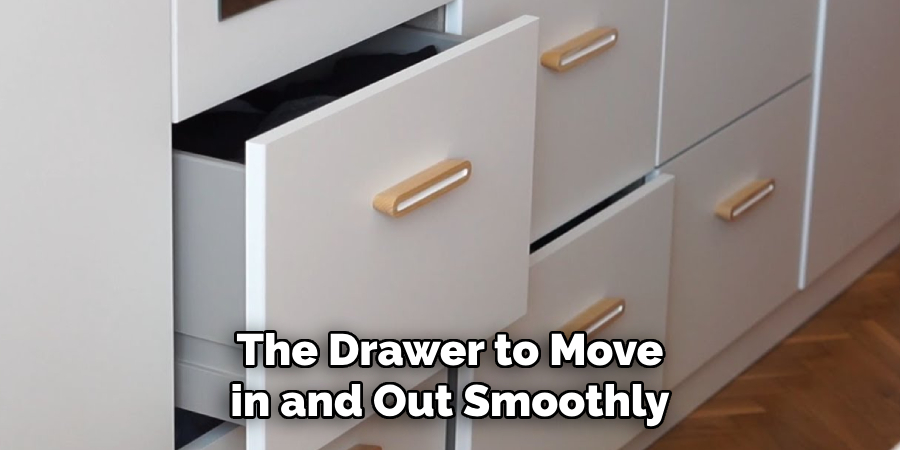
Drawer slides vary in design and functionality, including side-mount, under-mount, and center-mount types, each catering to different installation requirements and weight capacities. Some advanced slides also feature additional characteristics, such as soft-close or push-to-open functions, enhancing user convenience and safety.
By selecting the appropriate drawer slide type and ensuring its proper installation, the optimal performance and longevity of the drawer can be achieved.
Conclusion
In conclusion, preventing drawers from falling out is crucial for maintaining a safe and functional living or working space. From incorporating drawer stops or catches and selecting the right drawer slides to regular maintenance and proper installation, each step plays a pivotal role in ensuring the stability and longevity of your drawers.
By adopting these practices and avoiding common pitfalls, you can protect your belongings from damage, prevent accidents and injuries, and preserve the aesthetics and utility of your furniture. Remember, investing time and effort into maintaining your drawers enhances their performance and contributes to a more organized and efficient environment.
About the Author
Adrian Green, a lifelong woodworking enthusiast, shares his passion for the craft through The Woodenify Blog. With a foundation built on years of hands-on experience in his father’s woodworking shop, Adrian is dedicated to helping others learn and grow in the world of DIY woodworking. His approach to woodworking combines creativity, practicality, and a deep appreciation for the art of building with your own hands. Through his blog, he inspires individuals of all skill levels to embark on their own woodworking journeys, creating beautiful, functional pieces of furniture and décor.
Professional Focus
- Specializes in DIY woodworking projects, from furniture to home décor.
- Provides step-by-step guides and practical tutorials for woodworkers of all skill levels.
- Dedicated to helping readers build confidence and skill through easy-to-follow instructions and tips.
- Passionate about fostering a community of makers who can share, learn, and grow together.
Education History
- University of Craft and Design – Bachelor of Fine Arts (BFA) in Woodworking and Furniture Design
- Woodworking Apprenticeships – Extensive hands-on training with skilled craftsmen to refine carpentry and furniture making techniques.
- Online Courses & Masterclasses – Continued education in advanced woodworking techniques, design principles, and specialized tools
Expertise:
- DIY woodworking, carpentry, furniture making, and home décor projects.
- Creating accessible tutorials and guides for beginner to advanced woodworkers.
- Sharing the joys and satisfaction of woodworking, from raw materials to finished products.
